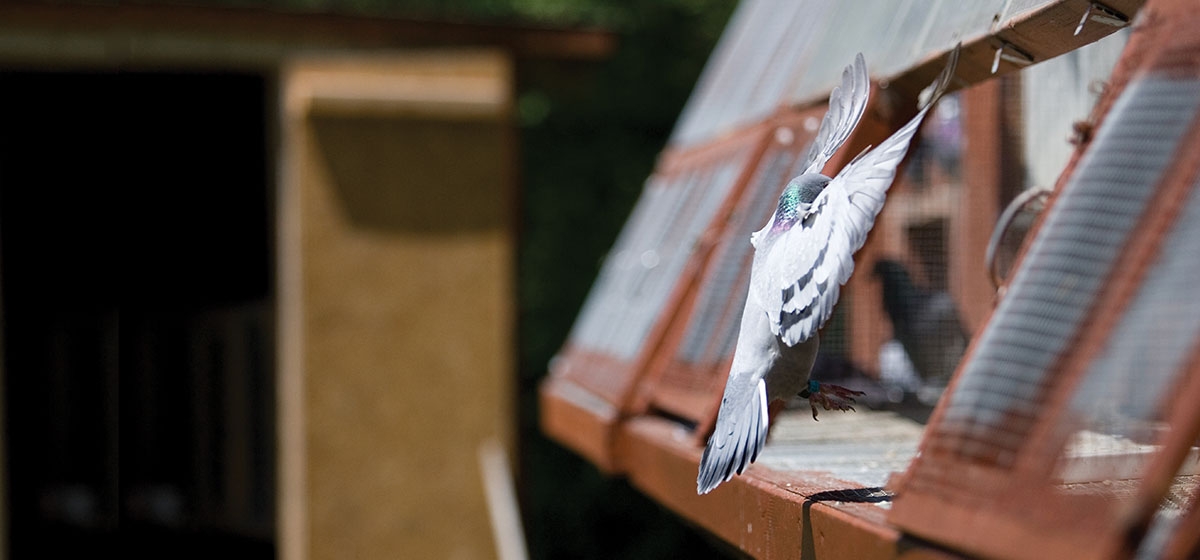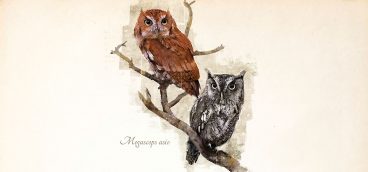A Flight of Fancy

A casual glance at Tom Erdner’s Gibsonia patio on this fine Sunday wouldn’t reveal anything unusual. But there are a few clues. For instance, on the table where he’s sitting, there’s a pen, note pad, watch, calculator and cell phone.Then there’s the serious look on Erdner’s face as he keeps looking back at the western sky.
As each minute passes, a quiet tension builds.
The day before, Erder and eight other members of the Harmony Racing Pigeon Club had packed 214 birds into crates and shipped them to Englewood, Ohio. Sunday morning, the birds were released simultaneously to race back to their home lofts in various places around Pittsburgh.
Conditions were good for the flight home: Clear sky and wind at WSW and only 7 mph.The trek back—236 miles, give or take—varied for the birds, depending on the distance from their home loft to the starting point. That distance is measured down to the yard. Intricate clocks record arrival times, and the clocks are sealed in case there’s temptation to cheat. The top finishers may be separated by seconds.
9:45 am… As they often do on race day, two of Erdner’s “pigeon” friends have dropped in. Sitting with coffee, they reminisce about past races and certain winning birds and pigeon men they have known. They discuss today’s wind and distance and speculate on how soon the first bird back should appear. Similar conversations are taking place at other area lofts and patios and back yards on this Sunday morning.
The Harmony Club is one of five in what is called the Penn-Ohio Combine. If all clubs had raced, several thousand birds might have been released at once. After circling several times, the flock would start east. Hours later, loosely strung out but closer to western Pennsylvania, individual birds would begin to break away toward their various towns and home club lofts. At this point, to win or be in the money, a bird ideally would fly a straight line route to its loft. Those that wander or over-fly will be late.
Theories abound, but how the birds navigate remains a mystery. The late Melvin Kreithen kept a loft of homing pigeons on the roof of Langley Hall at Pitt, where he was a biology professor. Despite extensive study, he failed to solve the riddle but did prove that birds released near radar stations or electric transmission towers appear hesitant and confused or even refuse to fly. The theory that homers use some form of imprinted, “magnetic map” navigation is popular with most enthusiasts. How else to explain racing pigeons returning from 500 miles over land they’ve never seen before?
Erdner, 57, is a communications consultant with Bayer. His interest in racing pigeons began when he was a 10-year-old kid in Avalon watching a neighbor’s homing pigeons swinging gracefully through the air above the neighborhood. He thought they were beautiful. His brother Eddie had a chicken coop and, after some friendly persuasion, young Tom turned part of it into a loft with some authentic homing pigeons. Not ugly, street pigeons that fanciers (and most pedestrians) despise; these were pure bred, pedigreed, racing homers that could be taken to far away places in Ohio or Indiana and released to successfully find their way home.Erdner was hooked.
On this morning of waiting and watching, Erdner gets a call at 10:30 from a competitor in Flushing, Ohio, who, a few minutes earlier, “clocked” his first bird. That flier, who lives 70 miles further west, computed his pigeon’s speed at 53 mph. That 70-mile differential will be calculated when race results are computed at the club. Erdner figures he must get a bird before noon to win. And a proven winner from his loft,“The Raptor” of the Houben breed, is in this race. Erdner thinks the three-year-old hen might be his first bird back.He turns with a smile to his friends: “Now I’m tense!”
In Europe, pigeon racing has been and remains a common man’s uncommon sport. The number of racers here climbed with the wave of immigrants in the 1920s and 1930s, as workers in the coal fields and steel mills brought their precious pigeons with them or acquired new ones. In the ’40s, ’50s and ’60s, middle-class back yards throughout the region were sprinkled with pigeon lofts. If you had walked down the streets and alleys of any western Pennsylvania mill town at that time, you’d have been astonished by the number of lofts. Old-time area fliers believe there were as many as 30 clubs with more than 1,000 active members in southwestern Pennsylvania.
Brothers Ray and Rich Dinklefelt, now in their 70s, got started as boys in Braddock. They meet at an area coffee shop every week with friend Andy Blasko. The trio has been involved with racing pigeons since the late ’50s. Now, they estimate that fewer than 300 Pittsburgh fliers remain. Bud Welty, who has raised homing pigeons since 1949 when he was 9, is less optimistic. Welty claims the number of local competitors has fallen to 200.
How to account for the shrinking numbers of fliers in this area? Rich Dinklefelt says costs discourage newcomers. That includes the cost of acquiring quality breeders, expensive pigeon feed, sophisticated timing clocks and the price of gasoline in transporting birds. He also points to local ordinances that can prohibit the traditional practice of backyard loft locations.
In Florida, California, New York and New Jersey, the number of racing pigeon fliers are growing. In other states, the sport is holding its own.Asia is beginning to rival Europe in numbers of enthusiasts.Pittsburgh area fliers view all this with envy.
If the number of Pittsburgh fliers is down, the level of competition is up. As with thoroughbred horse owners, there are consistently successful fliers and those who want to be. Buying proven blood lines and pedigreed birds doesn’t guarantee success. But the price goes up for birds from winning lofts.
Popular magazines devoted to the sport, such as The Racing Pigeon Digest, are filled with glossy ads offering descendents of winning racers for as much as $1,000. A recent full-page ad offered a bird from famous parents for $3,500.
Those same colorful ads often include close-ups of a consistent winner’s eye. Many fliers believe that a pigeon’s potential can be measured by the shape and color of a ring around its pupil. Others scoff, claiming the only way to measure a bird’s value is by its racing performance. Still, there seems to be a convincing correlation between the eye and racing success.
As minutes slip by, Erdner assumes his chances of winning first place are also slipping away, but he hopes to finish well. At 11:45 a Broadwing Hawk circles in the sky. In 1972, hawks and owls were placed on the protected list in Pennsylvania, and their numbers soared. Pigeon racing men all report losing birds to hawks on a regular basis. Hawks sit in nearby trees waiting to strike. Such an appearance can delay or even prevent a race bird from entering the loft and recording its time. Erdner tries to will the hawk to leave.
Lou Arcuri’s loft sits on a West Mifflin hilltop high above Kennywood Park. He first acquired homing pigeons in 1944 at 14. At 18, he began a lifelong career in the J&L Steel plant. Triple bypass heart surgery in 1998 and a stroke in 2005 slowed but didn’t end his successful pigeon racing career. On race days he shows surprising speed hurrying to the loft when that first bird returns.
He attributes his racing success to training and conditioning. His main breeding blood lines of Schaerlacken and Huskin Van Reil are from Holland and Belgium, respectively. Arcuri visited famed racer and breeder Ad Schaerlacken overseas three times, bringing back both birds and racing wisdom.
Arcuri is among local competitors who enter so-called “futurity races,” which offer extraordinary prize money. Where the winner of a regular race staged by a local club might win up to $1,000, Florida’s Flamingo International Challenge offers the winner $100,000. Nevada’s Vegas Classicboasts a stunning first-place prize of $200,000. With futurities, racing enthusiasts across the country are invited to buy special futurity identification bands to be placed on a pigeon’s leg when the bird is a few weeks old.A single band might cost up to a $1,000. The bird is then shipped to a central loft to be joined by hundreds of others, all of whom imprint that loft’s location as “home.” Paid handlers train the pigeons up until race day. The number of bands sold for a single race dictates the total purse, which can easily reach $500,000. Even finishing as low as 30th or 40th could mean a few hundred dollars in prize money.
Last year, Arcuri says, his futurity winnings were $10,000. For most Pittsburgh area fliers, the high entry costs make futurity racing too risky.Although local club prizes can be modest, just winning enough to cover feed costs can be a blessing.
At 11:48, Erdner’s pigeon, The Raptor, suddenly and dramatically slants in out of the sky, dips to the landing board and drops through to the loft. One minute later Erner’ssecond bird lands. At 11:50, three arrive together in a flurry. Hours later, after meticulous computation at the club, Erdner’s first three returning birds are ranked 4th, 5th and 6th.
In the following week’s 335-mile race from Beechgrove, Ind., one of Raptor’s sons took first place. On May 13, a 236-mile flight from Englewood, Ohio, the Raptor herself scored a victory.
Pigeon racing results in Pittsburgh don’t show up even in the back pages of the newspaper sports section as they once did. For those still competing, however, Sunday afternoon by the loft, watching the sky and thrilling to the sight of that first bird back, rivals a Steeler victory.
At club headquarters around the area, laughing, beer-drinking competitors toast the winners. Losers and also-rans mutter, “Wait’ll next week” in a tradition repeated down through the years.





